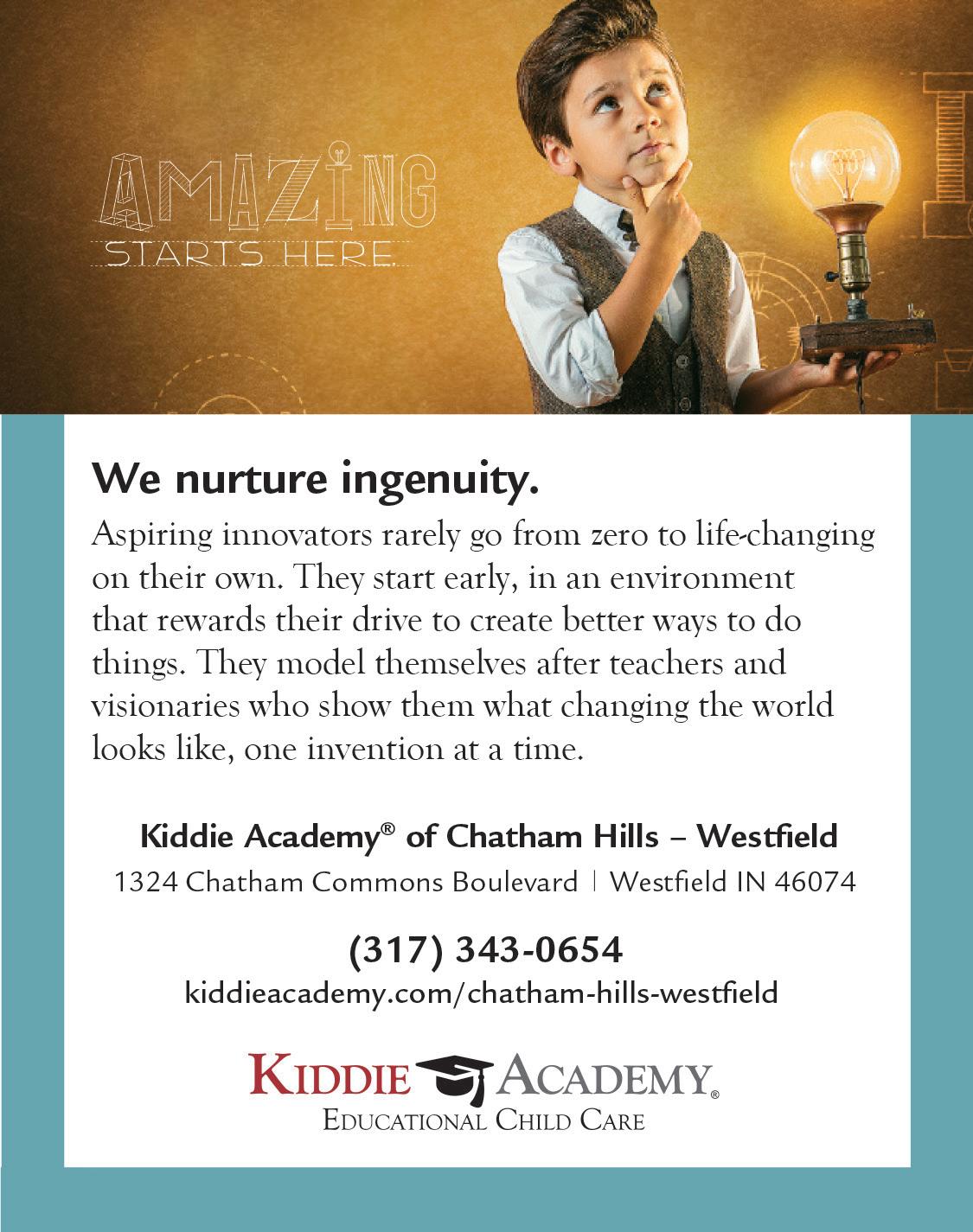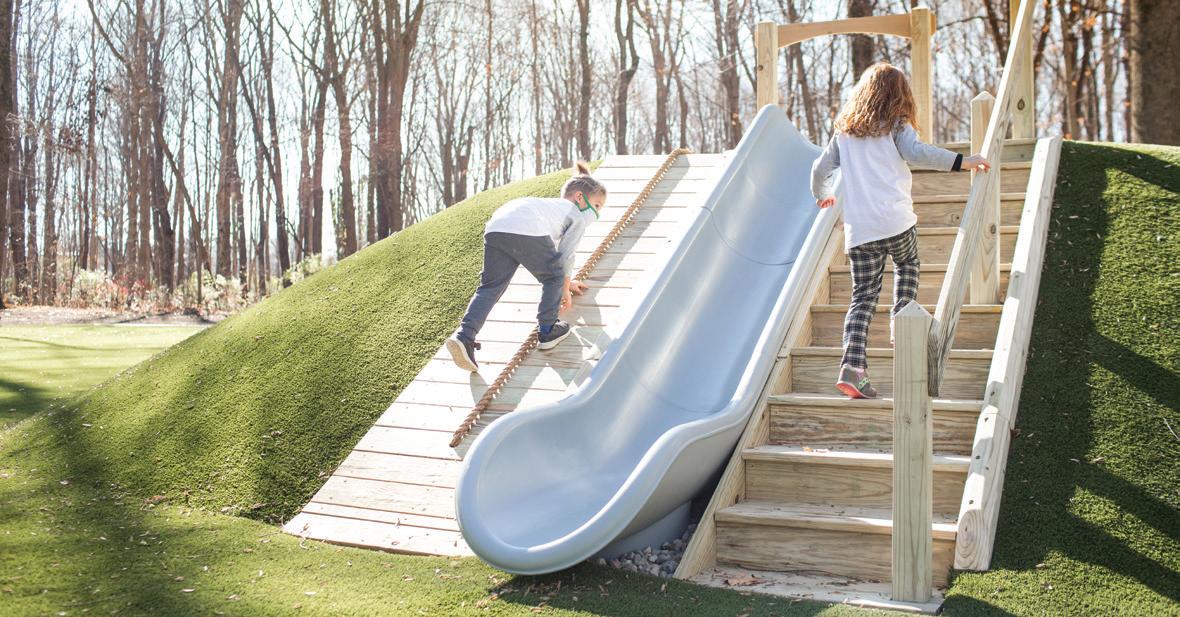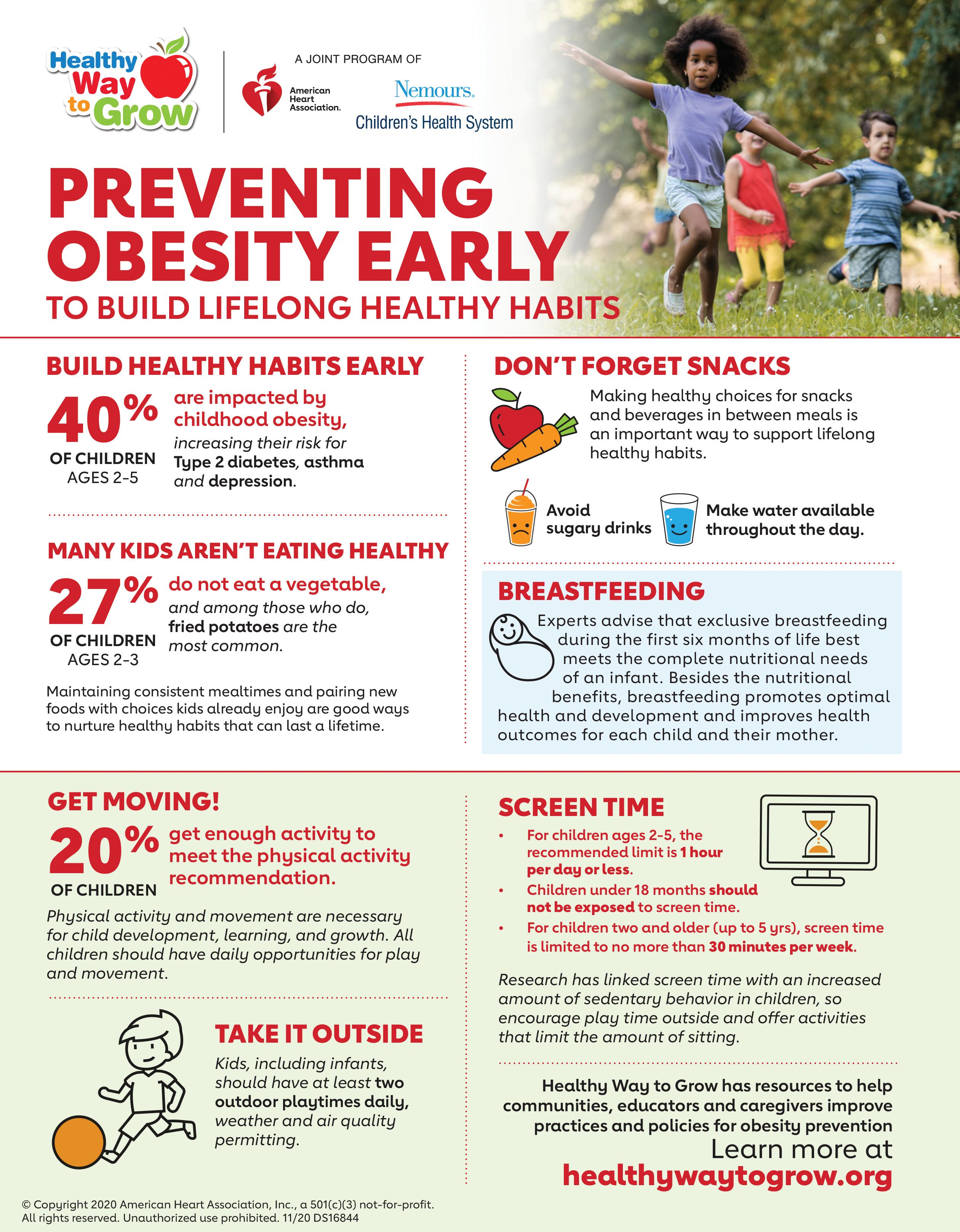
10 minute read
The Orchard School's New Nature Playgrounds


This Indianapolis school combines teaching, learning and playing with new natural playgrounds.
Nature has always been part of the curriculum at The Orchard School. Now, students will have even more nature to explore.
The Orchard School recently finished construction on three new natural playgrounds on campus, with the idea that they will serve as so much more than just playgrounds. They are outdoor classrooms, an outdoor oasis, and a world of learning and exploration. These new spaces complement all of the existing outdoor learning spaces at Orchard, and provide even more opportunities to inspire creativity and the natural curiosity of children.
The natural playgrounds include three outdoor covered amphitheaters with electricity and Wi-Fi, climbing walls, gaga pits, tree decks, sensory paths, musical play areas and plant-based Astroturf covering massive play hills. These playgrounds will allow students to have an incredibly unique learning experience. The possibilities are endless and will serve Orchard students and the community for years to come.
Orchard reached its goal to complete three new natural playgrounds in September 2020. The school community came together to raise more than $1.4 million to complete this project, which is part of their $11 million capital campaign, "Celebrating our Roots. Cultivating for the Future."
Everyone is invited to see these one-of-a-kind playgrounds at Orchard's open house on May 16. RSVP at orchard.org/tour.
BROUGHT TO YOU BY




On any given day, 13,000 children in Indiana enter the foster care system, needing a safe and loving home where they can grow and thrive. Foster care offers temporary care — as little as a couple months and as long as a few years — for children whose biological parents are unable to do so. While many families who foster also choose to open their homes for adoption, the ultimate goal of foster care is to reunite children with their parents.
Foster families don’t have to look a certain way — you don’t have to be rich or married or even have children of your own. If you have considered fostering but aren’t sure you have what it takes, it’s a path worth exploring, as it can have a lasting impact on a child’s life.

Getting Started
The first step on your fostering journey is choosing a foster care agency to work with, and it’s important to find one you’re comfortable with. The agency will walk you through the licensing process, which differs from state to state, and support you once a child is placed in your home. Most agencies offer information sessions where you can learn more about fostering needs, as well as the agency itself.
When checking out prospective agencies, consider if they are publicly or privately operated, what services and supports they provide, the office’s proximity to your home, and any costs related to licensing. Once you’ve selected an agency, you can begin the steps to becoming a licensed foster care provider, including completing pre-service training and a home study.
Indiana requires at least 10 hours of pre-service training, though more may be required depending on the agency you work with and the type of licensure you’re seeking. You’ll be introduced to things like the child welfare system, how to set up your home, the child’s support team, principles of trauma-informed care and behaviors to expect in foster children. This initial training is followed up with 15 hours of ongoing training annually for recertification.

The home study is an extensive report that usually takes about three to six months to complete and provides a broad overview of your life so that a child can be matched to your home. A case worker will interview you, your family and others, and will include information about your relationships and social life, the neighborhood you live in, your financial status, daily routines, parenting experience, and why you want to foster. It will also include a medical assessment, background checks and references.
What To Expect When Fostering
Once a child is placed in your home, your biggest role is to provide them the love and support of a family. However, this includes some additional responsibilities.
You can expect the case worker from your agency, as well as the child’s case worker and other providers, to make regular home visits based on your child’s needs.

“In other words, there will be lots of people in and out of your home to surround you and the child with the supports needed for success,” says Brenda Chapin, vice president of program administration for The Villages, an Indiana-based foster care and adoption agency.
You’ll also need to make sure the child can get to medical and other appointments, court appearances and visits with their biological family. While you will not be paid for your service, you can expect some reimbursement from the state for part of your child’s care.
G E T T I N G S T A R T E D I N F O S T E R C A R E
The road to foster care might seem long and intimidating, but here’s a map to help navigate your way through.
WORDS BY RACHAEL DUPREE
A lot of emotions can be tied up in fostering, and it’s important to take a realistic look at what’s involved in the process. Here are some questions to consider as you start on the fostering journey:
• Can you support the goal of reuniting children with their biological parents? “Children love their parents,” Chapin says. “This does not change when a child comes into foster care.” Families hoping to eventually adopt may have conflicting feelings when a child returns home.
• What age levels and special needs are you capable of supporting? Chapin recommends being open-minded but realistic about this. “People tend to think that older teens are always really difficult to foster, but often these are youth just looking for some stability so they can do ‘typical’ things that others their age are doing, like being on a sports team or hanging out with friends,” she says. “Younger children often require a much higher level of attention and care.”
• Is your family on board? Fostering should be a family decision. “Talk to your children about becoming a foster home, as it is their home, too, and fostering will have a significant impact on their daily lives,” Chapin says.
Overall, foster parents need to be able to be committed to the care and development of the children in their home. Fostering has its challenges at times, but they can be easier to handle with realistic expectations and a strong commitment to the children you serve.


CARING FOR YOUR HEART AT ANY AGE

Don’t become the victim of America’s No. 1 killer of women. Take steps now to ward off heart disease.
WORDS BY RACHAEL DUPREE
When it comes to matters of the heart, the outlook for American women is rather grim. We’re talking about heart disease, not romance. The top threat to women’s health, heart disease claims the lives of one in three American women every year, with 90 percent of women having at least one risk factor for developing heart problems. To complicate matters, doctors are just beginning to uncover femalespecific risk factors that have often been overlooked. As women, we’re often the caretakers of our families, and as a result, our own health can take a backseat. The good news is that no matter what your age, you can start making lifestyle modifications today to keep your heart healthy.
Your 20 s : Set a Healthy Foundation
Heart disease now affects more young people than ever before, thanks to the cultural epidemics of obesity and diabetes. But your 20s are a perfect time to start honing in on heart-protective habits, according to Emily Ruben, MD, a cardiologist at Ascension St. Vincent’s Women’s Cardiac Risk Clinic. “Creating habits early will only help you down the road,” she says.
Learn to Cook: A plant-based diet that incorporates whole foods, lean proteins and lots of veggies is a hallmark of heart health, Ruben says. By cooking for yourself, you gain control of what goes into your meals, including more organic ingredients and less salt and sugar.
Find Exercises You Love: Use your freedom in this stage of life to explore different modes of exercise to get in the recommended 150 minutes a week. Join a flag-football team, drop in on a hot yoga class, or explore Indy’s many bike paths. “The best kind of exercise is one that you enjoy and makes you come back to do more,” Ruden says.
Know Your Family History: If you don’t already know your parents’ and siblings’ heart history, now is the time to find out.
Your 30 s : Tune In
Emerging research shows that women in their child-bearing years have unique risk factors for cardiovascular disease, so if you haven’t already taken steps to developing a heart-healthy lifestyle, get in gear.
Monitor Your Pregnancy: Gestational hypertension, preeclampsia and eclampsia during pregnancy increase your risk of heart disease later in life, so you may need regular blood-pressure monitoring or the intervention of a cardiologist if you develop these conditions, Ruden says. Plus, you’ll want to work with your doctor after pregnancy to manage resulting risk factors.
Relieve Your Stress: While the trials of motherhood make it tempting to reach for a glass of wine or binge on Netflix, this is the perfect time to pick up healthy stress-management practices, like meditation or journaling.
Exercise with Your Kids: Busy moms may need to adapt their exercise regime during these years, and that’s OK. “I’d encourage women with young children to let children see you exercise,” Ruden recommends. Take them on a hike at the local metropark or have a dance party in the living room — but don’t feel bad about stealing away for a short high-intensity workout if you need some alone time.
Your 40 s : Be Proactive
As women transition to menopause, heart-protective estrogen begins to drop in the body, leaving you at higher risk for heart disease. It’s important to be mindful in these health shifts as you move into your 40s, when early menopause can occur.
Start Annual Checkups: If you don’t already have annual well-visits with your doctor, start getting in the habit. Regular checks of your blood pressure, blood sugar, cholesterol and body mass index will help identify risk factors and allow you to take necessary preventive measures.
Watch Your Weight:
Keeping weight to a heart-healthy level (less than 35 inches around the waist) can become more difficult after menopause, and maintaining a healthy diet and moving regularly throughout the day can help.
Avoid Estrogen
Products: Synthetic estrogen used to help manage women’s transition to menopause can actually increase risk of heart attack and stroke. Keep use of these products to a minimum or avoid them altogether, says Ruben.
Your 50 s : Stay Aware
As you age, it’s more important than ever to stay on top of your health. By knowing your own body and what symptoms of heart attack and stroke look like in women, you can get the help you need if faced with a real problem.
Actively Manage
Chronic Conditions: Keep on top of management practices recommended by your doctor for diabetes or high blood pressure to reduce the risk of heart problems.
Report Unusual
Symptoms: Some women don’t recognize that they are having a heart attack because the symptoms often look different than what men experience. Visit the American Heart Association (heart.org) to learn more, and talk to your doctor anytime you notice something unusual in your body.
Whatever your stage of life, it’s never too late to begin the journey toward a healthier lifestyle. You’ll reap the rewards no matter when you start, and your families will, too.













